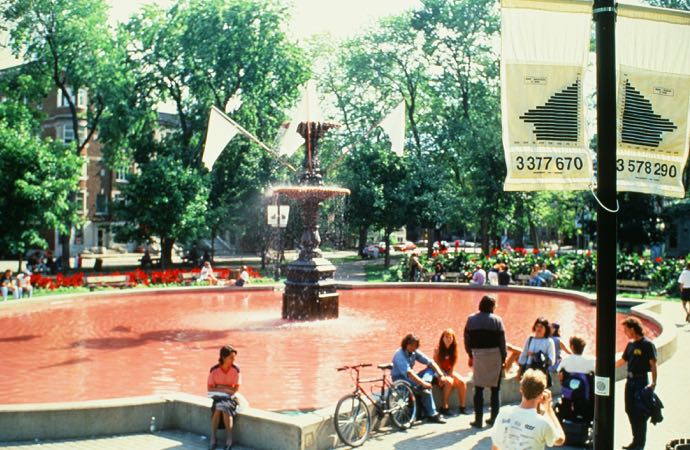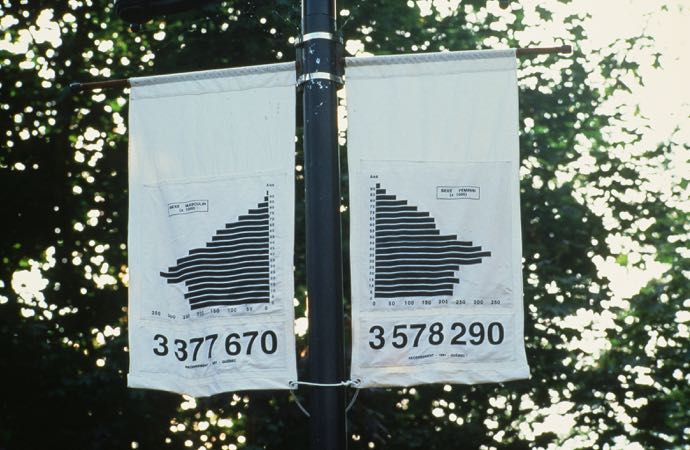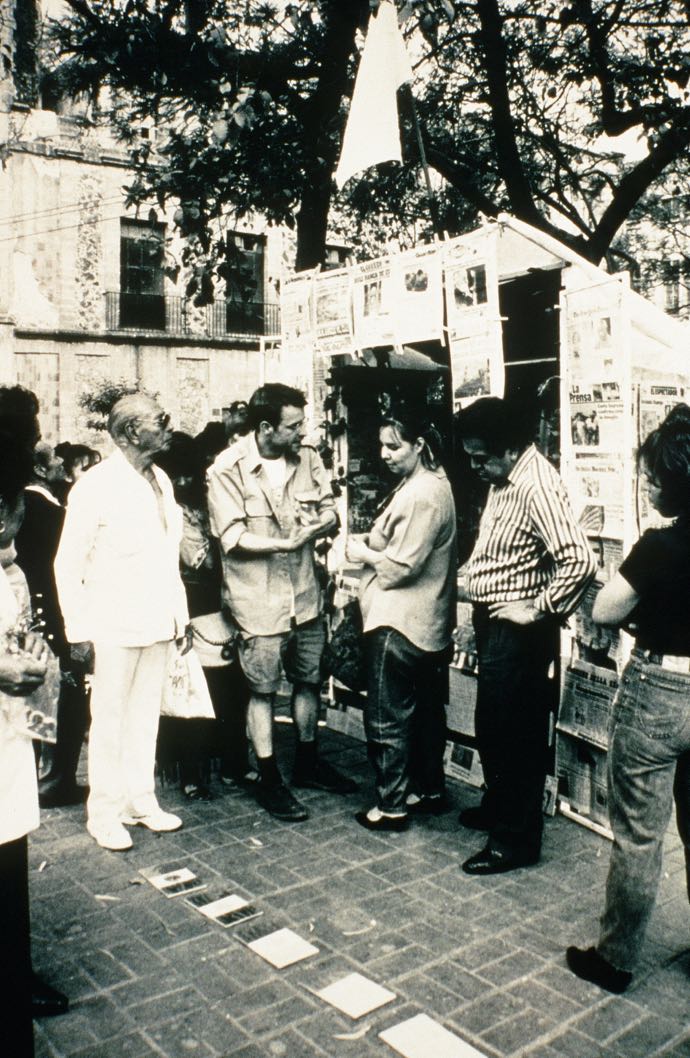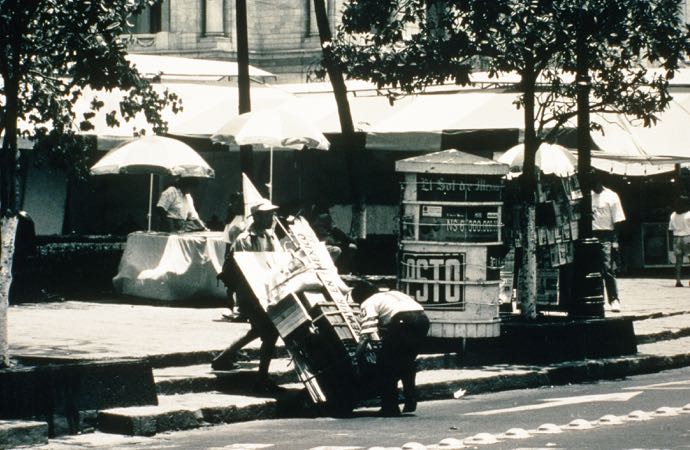A text written around 1995, during a collaboration with Pierre Allard, feverishly found in my archives and reviewed in the wake of the turmoil caused by his death on November 25, 2018.
After studying visual arts, Pierre Allard decided to present his work outside of traditional museums and galleries, in order to address people directly through the use of residual spaces in the city: vacant commercial spaces, vacant lots or urban furniture. Focused on the relationships that human beings have with their fellow human beings, as well as on the institutions and protocols that govern these relationships, his work favors a dialogue with the viewer as directly as possible. The use of public spaces allows him to reach a wider audience than the specialized public of the art world, recipients who do not usually have access to contemporary artistic production, and to touch the spectator in an intimacy lived in everyday life in order to ensure that the works have a longer term impact.
Between 1990 and 1995, a time when I was in regular contact with him, Pierre Allard produced a dozen anonymous installations/interventions identified by the verb “VIVRE” (LIVE). Around a questioning on the conditions of life in society, he realizes in a short time protean urban installations, and sometimes monumental.
In Ceci est la preuve (1990), he invites the viewer to wander alone through a dark corridor in the basement of a vacant commercial space on Saint-Laurent Boulevard. The sound of his footsteps, accentuated by a layer of coarsely crushed gravel spread on the floor, renders inaudible the already faint diffusion of human laments. In this first section, 24 clocks representing each time zone are fixed to the wall. Halfway through, the visitor is able to distinguish further into the darkness of the room a globe serving as a light source and allowing us to read the front pages of newspapers from around the world fixed to the wall, confronting us with the conditions dependent on the current events of each of these living environments. At the very end of his journey, he is surprised by a flash of light accompanied by an intense scream and photographed in his startle. The picture thus captured is then given to him stamped with the mention: “This is the proof that we know that you know”. More than 1300 photos were distributed, while 1500 people visited the exhibition.

With the 1991 ephemeral installations, The Temple, Surrender and The Column, Pierre Allard draws the viewer’s attention to the institutional processes and impromptu transformations taking place in urban space, and which hide its apparent functional neutrality.
The temple consists of a construction made of recycled materials in the shape of a classical temple, but left to normal deterioration and vandalism. It remained in place for nearly 18 days before being completely destroyed. In a similar vein, a white flag planted in the remains of a burned building in Surrender highlights the dramatic transformations that urban space is sometimes the scene of, and which citizens often bear the brunt of, as well as their handling by institutional automatisms, such as the erection of barricades hiding the sites of disasters, or their cleaning up by municipal authorities, thus lifting the veil on a certain “polis” acting on public life as much as on citizens.

In 1992, in Les Bouddhas, two identical Buddha figures, one in perfect condition, the other partially destroyed, are presented in windows framing the main entrance to a vacant store on Saint-Laurent Boulevard. The backdrop of the display space is lined with newspaper pages, easily readable and bearing witness to world news. Confronted with the inaccessibility of the commercial exhibition space, with the staging of an act of vandalism associated with the layout of this enigmatic place, the viewer will then perceive over the course of the weeks that pass the deterioration due to the sun of this singular presentation. The shop window distinguishes itself from a traditional exhibition space removed from a normal living environment. In this simple composition, references to an attitude of contemplation opposed to a smashing action, a typical museum presentation and the commercial display in the window, the public space given over to private interests on both sides of the glass and the global social context to which the presence of newspapers testifies. Various registers of human activity, subject to institutions and conditioning, rather than freely expressed, are thus played out before us. In the same way, the installation L’impossibilité confronts us with the omnipresence of lampposts on Saint-Laurent Boulevard, with their strategic visibility, but with their relative inaccessibility, shining the spotlight on a certain dynamic of organization, even of surveillance, linking the passers-by and the users of the public way to the official authorities and to the power games of the city.
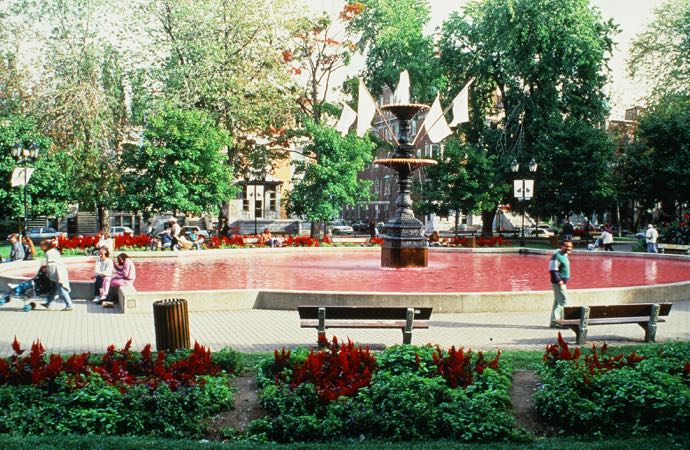
Inspired by the pomp and circumstance of public celebrations or political conventions, the installation Carré Saint-Louis, presented by Oboro outside its walls in the fall of 1993, blends panels and banners, newspaper and paint interventions, and sound recordings with the layout of this well-known and much-frequented urban square in Montreal. At the northeast entrance to the park, a mobile panel covered with newspaper clippings from around the world presents three dynamic counters counting, under the headings “They will live”, “They live” and “They lived”, the births, inhabitants and deaths of the world’s population, according to the statistics of the United Nations.
In the square itself, a bunch of white flags dominates the central element of the fountain whose basin is painted red, the vespasian located in its western part is plastered with newspaper clippings, as are several public benches. Not perceived as vandalism, the whole contributes to the festive atmosphere of the place. Banners lining the paths on both sides display statistics characterizing the world’s population, notably according to age or gender. This urban spectacle conveys, behind its festive airs, information on the social inequities on a global scale and the precariousness of the living conditions of certain individuals.
In parallel to this public square, as an echo and symbol of peace, twenty-five white flags were raised on the facades or atop various public and commercial buildings in the downtown area, including the Montreal Central Library (then Sherbrooke Street), Oboro, presenter of the event (4001, Berri Street), the Montreal Museum of Fine Arts (Sherbrooke Street West), the Élysée cinema (corner of Milton and Clark Streets), the Guaranteed Pure Milk dairy (corner of René-Levesque Boulevard and Lucien-L’allier Street), an office building (on Sainte-Catherine Street near Metcalfe), etc. The ensemble underlines the social function of these different institutions, the relationships of force and power that they represent, and the human relationships that they govern, while raising questions about the human condition, with regard to the same issues on a global scale.
Behind this VIVRE, Pierre Allard’s early works bear witness to his active commitment to social issues, which never ceased to mobilize him and his wife Annie Roy within Action terroriste socialement acceptable (ATSA), which they founded together in 1997. We will now have to learn to invest his legacy without him. “Hail the artist” passed away prematurely at the age of 54.
“Only those who are forgotten die.”
From an unpublished text revised in December 2018 to pay tribute to this exceptional being, this friend too soon gone.









